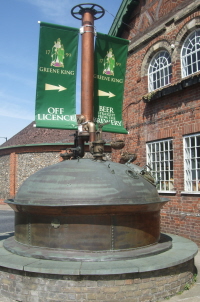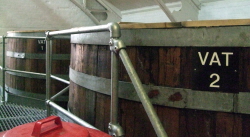Brewery visits are some beer writers’ bread and butter but I confess I’ve been on very few. Certainly, visiting Greene King, now probably the UK’s biggest brewer that isn’t a multinational, wasn’t high on my to-do list. But then I was in Bury St Edmunds, Suffolk, with a brief to develop some pub walks (of which more in a later post), with a room at the Dog and Partridge almost opposite the Westgate brewery. I could see the steam venting from the brewing vessels into a balmy June sky, spreading the sweet, slightly sickly aroma of cooking barley malt over the town’s closely packed mediaeval streets. Answering its siren call, I found myself at the brewery visitor centre as part of a small group on a Saturday morning tour conducted by the affable and very knowledgeable Henry Logan.
With its landmark site on the edge of an historic urban centre already rich in visitor attractions, Greene King is well placed to welcome interested sightseers, and has responded in some style: besides the tours there’s a museum on two floors, which perhaps overfavours information boards and dummies in period costume over hard exhibits but is well presented and informative, and an attractive and very friendly shop stocked with bottled beers and breweriana. Quite rightly both tour and exhibition assume no particular prior knowledge of beer and brewing and play their role in raising awareness of beer in general as well as the specifics of how things were and are done at Greene King.
These days, it’s fair to say Greene King may well figure lower in some beer enthusiasts’ affections than its fellow Bury brewer, the tiny Old Cannon brewpub on the opposite side of the town centre, but things were not always so. Back in CAMRA’s 1970s heyday, GK was one of the regional family brewers revered for having kept the faith with cask beer, and its strong bitter Abbot Ale was a real ale icon. The brewery emerged one of the few winners among its peers in the massive shakeup of the industry following the 1989 Beer Orders, transforming itself into a “new national” of a size equivalent to members of the now long vanished Big Six, the reviled national brewers with whom CAMRA had originally locked horns.
It reached its current size by borrowing many of the Big Six’s tactics. Numerous breweries have been bought and shut down, their pub estates absorbed, their brands cherry picked with the best known recreated, not always very faithfully, in Bury. There’s nothing new in this — the company in its present form was created when Frederick King’s St Edmunds Brewery merged with Edward Greene’s neighbouring Westgate Brewery in 1887 (the foundation date on the logo, 1799, is the year it’s assumed the Greene family first bought the Westgate Brewery, the original foundation of which is unknown).
Takeovers have been a regular occurrence throughout its history but a succession of them in the past decade has attracted renewed controversy. In 1999 there was Morland of Abingdon, which had already acquired Rutland brewer Ruddles. In 2005 GK acquired both Belhaven in East Lothian and Ridleys of Essex, including the brands of former Ipswich brewer Tolly Cobbold, then in 2007 Nottingham brewery Hardys and Hansons was absorbed. During the 1990s GK had also finally shut two longstanding subsidiaries, the Wells and Winch brewery in Biggleswade and Rayments of Furneaux Pelham. Its only other remaining production site is now Belhaven’s base at Dunbar.
The pubs acquired through these deals, together with acquisitions of freestanding pub companies, have bloated GK’s estate to 1,700 houses across the UK. This, alongside supply deals with other pubcos, has given it significant clout to control its cannily marketed brands, and a near monopoly of consumer choice in some areas. Production processes have been streamlined — old fashioned square fermenters have been replaced with massive conicals, and whole leaf hops has been rejected in favour of pellets, which, as Henry informs us, have a much longer shelf life and can be bought in greater bulk at more favourable prices. Complaints about loss of character have inevitably followed. The “beer of English Rugby”, Greene King IPA (3.6% ABV), the company’s biggest seller and the best selling cask session ale in the world, is to my taste a rather plain and bland beer — despite its surprise Champion Beer of Britain silver medal a few years back, even in top nick it’s little more than an inoffensive quencher with some cask character. It’s also viewed with disdain by some connoisseurs as the beer most responsible for devaluing the meaning of the term India Pale Ale. The once legendary Abbot, many drinkers will tell you, is a pale shadow of its former self.
And yet…one key difference between Greene King and the old Big Six is that, alongside its fellow new nationals, it holds a commitment to cask ale of a reasonable standard of quality at the heart of its business model. This is reflected in the displays and the tour, both of which raise awareness of cask beer and its importance. At one point Henry shows us both a cask and a keg, explaining the different techniques for filling and tapping them and detailing in particular all the hassle and skill involved in dealing with the former. “At this point you may be asking yourself why we bother,” he comments. “The answer is quality and taste. You simply can’t get the same taste out of a keg as you can out of a cask.” For all the modernisation and the new packaging facility that can fill a cask in 25 seconds, this is still a traditional British ale brewery based on infusion mashing which doesn’t even attempt to brew lager. The kegged and most of the bottled beers, though sterile filtered and recarbonated, are now unpasteurised, the exception being the bottle conditioned Hen’s Tooth. And there are still rows of old fashioned square fermenters supplementing the huge conicals.
Doubtless primed by long experience of the barbs of beer campaigners, Henry robustly pre-empts criticism of the brewery’s takeover record. “The economic reality is that those breweries would have closed anyway,” he says. “It’s thanks to Greene King that brands like Old Speckled Hen, Olde Trip, Ruddles and [the recently revived] Tolly Cobbold are still around, and we’re proud of protecting that brewing heritage.”
So tradition and heritage are still very much part of the discourse, but less superficially than the strategically positioned horse-drawn drays scattered round the brewery buildings and the vintage copper on the pavement outside the visitor centre might suggest to cynics, genuinely reflecting aspects of everyday brewing practice. The original Westgate Brewery buildings are still part of the site, though the heart of the operation is the red brick art deco landmark next door, still referred to as the “new brewery” though dating from the 1930s. Inside is a brewing palace in Italian marble that still works on the tower principle where the basic ingredients start at the top and gravity gradually nudges them downward through the various brewing processes — the basic pale malt is pumped from silos but the speciality malts are still added by hand to the grist mill from neatly stacked 25kg sacks. The fermenting rooms are in King’s old St Edmund brewery across the road, with a complex of underground tunnels connecting the two, sadly no longer included on the tour for health and safety reasons.
Happily, the health and safety police haven’t yet ruled out a visit to the New Brewery rooftop, the best view in Bury. To the north you can see the site of the town’s most celebrated piece of heritage, the former St Edmund’s Abbey, one of the richest and most powerful institutions in the land before being dissolved and plundered by Henry VIII. There’s the Norman Tower, beautiful St Mary’s church, the cathedral with its tower absurdly added in fetishistically faithful Gothic Revival style in 2005, and the abbey ruins nestling in a fold of the river Lark. Where the abbey precincts end, the brewery land begins, in a vast sweep south and southwest, taking in not only the core brewery sites and the newer packaging plant with its linking pipes but swathes of model houses built for brewery workers and much else besides. The estate includes the freehold of the Theatre Royal, the only surviving Regency theatre in Britain, once used a barrel store but now leased to the National Trust and extensively restored a couple of years back; and extensive flood meadows along the river Linnet, now managed as a nature reserve.
And then there’s something else that puts Bury St Edmunds firmly on the international brewing map which Henry is certainly not going to miss. “Now I’m going to show you something really special,” he tells us, “that you won’t find in any other brewery in the UK.” Past those old square fermenters are two 100-barrel (16,366l) oak vats which are used for maturing Old 5x, a legendary 12% beer, for between two and five years. There were once three of them, kept in the tunnels linking the sites and famously sealed with Suffolk marl, but one collapsed and the remaining two are in the fermenting room, with no marl in sight. A cooper who can build a new one has finally been located — this is destined for a space where a defunct square that recently suffered an implosion now stands.
Henry is strictly speaking no longer entirely correct to say this is the only remaining example of wood ageing of beer in Britain, but I can forgive him for not acknowledging the odd micro experimenting with the odd empty whisky barrel. Greene King is certainly the only British brewery still maturing in wood on this kind of commercial scale, and in doing so it is preserving a living link with 18th century brewing, where this kind of vatted “stale” beer was key to common styles such as porter. You’d have to visit one of the few Flemish breweries still souring brown ale in wood, such as Rodenbach in Roeselare, to find anything like these vats in another European brewing facility.
GK has long been notoriously reluctant to let 5x out on its own, and currently only sells it in blended form, most notably in its old ale, Strong Suffolk. Here it’s cut with BPA, another historic brew not available on its own, a Burton Pale Ale in a near lost style that’s in fact rather dark and sweet — Young’s Winter Warmer is perhaps the most readily available survivor. 5x has also recently been blended with Old Speckled Hen to create Old Crafty Hen, and an unaged version is used in the new Suffolk Springer. All three of these 5x beers are reviewed in the previous post. It’s frustrating to be within reach of these beery grails but unable to sample their contents — polite enquiries are gently rebuffed with the line that only brewers get to taste Old 5x au naturel.
I think Greene King is missing something here. Henry says that production costs and high duty would make the beer so expensive nobody would buy it. I’ve also read head brewer John Bexon saying the tart, acidic quality of wood aged beer would be offputting to consumers. But the beer world has moved on since these opinions were formed. There’s a growing interest in rare and historic beers, and a willingness to pay for something special.
A bottle conditioned version of undiluted Old 5x, perhaps released as an annual vintage dated limited edition, would attract considerable interest from beer enthusiasts, particularly in the US market. A naked release of BPA might cause rather less of a stir but would certainly be appreciated by connoisseurs. Such a move would reaffirm the brewery’s commitment to its heritage, and remind those who judged Greene King only on IPA that something uniquely special still ripens slowly in the bosom of one of Britain’s biggest breweries.
Update March 2013. In 2012 Greene King made neat Old 5X available in cask at certain beer festivals — read a review here.








Nice article.
I’ve been to Greene King, and since I was a brewer from Quebec visiting old breweries for inspiration, they made an exception (lucky!), and our group had the chance to taste the Old 5X. Damn it was good. It was not so tart, but it was really dry, and for a beer that strong, it was something unexpected. I agree with you, they’re missing something in not letting people discover it.But, I hope that beer connoisseurs will notice our little brewery in Quebec, Brasserie artisanale Albion, which will try to create some unique brews like these old ales of the past, and aged Porter! 🙂
GK certainly let a bunch of beer writers taste Old 5X “from the cask” when they commissioned a new maturing vat back in (IIRC) the final years of the last century, and they even left us take a small bottle each home. V fine it was too. As you say, Des, considering how much the US market would love 5X and BPA, it’s astonishing Greene King don’t release them separately.
[…] Des de Moor – Greene King: The Joy of 5X […]